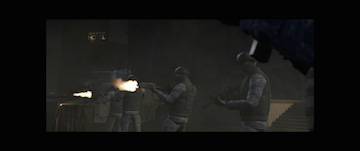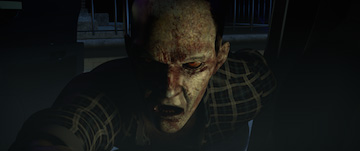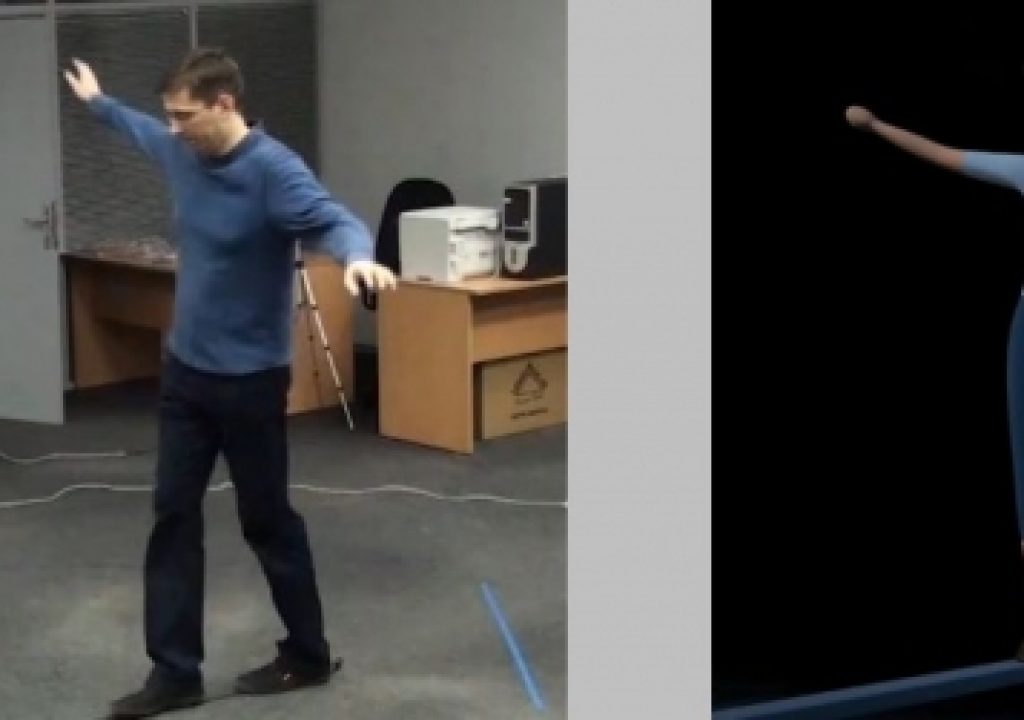
Night of the Living Dead: Origins 3D, a 3D animated reboot of the original 1968 horror classic. The film features visual effects from The Graphic Film Company that relied on the iPi Soft markerless iPi Motion Capture software solution. iPi Soft is a developer of markerless motion capture software, and their solution accelerates creativity easily and affordably.
We talked with Anthony Hoit, Graphic Film Company’s Chief Systems Administrator and Stereographer/Technical Director on the film, to learn more about how the technology impacted the story and the production. We also discussed the opportunities that are opened up with motion capture software solutions and he tells us the best approach to exploring the technology.
ProVideo Coalition: How does motion capture software come into play during pre-visualization?
Anthony Hoit: Motion capture allows filmmakers to work much faster, in a pre-visual sense, than trying to do it by hand. With faster iterations, more creativity is available in much shorter time frames.
The thing about the Kinect motion capture is that it's not final animation. You're going to have to go back and clean it up a little bit anyway. It's a much cheaper system and it can get you 90% there, but you still need to put in more work. So if you're going to do final motion capture, then you would need a much more accurate system. All of it expands beyond pre-visualization, but it takes more work.
 What sort of creative opportunities are opened up with motion capture software solutions?
What sort of creative opportunities are opened up with motion capture software solutions?
With this technology, you no longer have to hand animate everything. It's not going to replace hand animation, because that's a style in and of itself, but if you're looking to capture people and replicate what we're doing in real life in CG this technology is a perfect fit. A director, unfamiliar with animation, can direct actors and capture that motion in real time. They'd be able to see that motion in the scene as opposed to waiting for hand animation to be turned around. You get to be in the moment longer and get more work done at once, and that can be essential when you're working in a production or trying to stay on schedule. You can direct your actors as if you're shooting it live, so you can take all of that and put it into a CG film and not necessarily wait for it to be hand animated. It goes much faster, and that means more creativity so you can stay “in the zone” that much longer.
What are some of most innovative ways you've seen motion capture software utilized?
Motion capture is not just limited to people. We use it for objects and flying vehicles and cameras as well. For a cameraman to operate a camera as he or she would in the real word, we are able to add their expertise and years of experience to the digital film making world. You can increase the quality of what you're putting together tremendously with little effort.
Personally though, I use it mainly for character animations. Pre-viz and then final animations. Obviously robots and things that are not human need hand animation. We also animated a helicopter with the system, because you can motion track anything. If you can mime it out with your hands, all of that motion can be captured in a digital environment.
Something that I've seen people do is use the techonlogy with motion graphics. Most people are used to creating motion trails in After Effects or whatever system they're using, but you can also create those with trails motion capture, and it sits in 3D space. So you can sit there and do motion capture of your hand that you want to exist in your motion graphics, and then transfer that into whatever package you need to have that motion. I've seen a lot of people utilize this method rathan than try to create what they want with the tools in the traditional way.
How has the landscape of motion graphics and motion design changed in the past few years?
Every year, everything changes. Somebody makes a new tool or someone figures out a way to do something automatically that previously took a lot of time. Everything gets faster. Creative leaders can sit with artists familiar with the tools and fine tune their design with great speed. That's resulted in much less “back and forth” as both sides try to get to an end result that they are satisfied with. The software does get better every year, but a lot of this change is also driven by artists and creative people that are trying to do these things faster. They create or develop a look or tool they need because it doesn't exist and they're trying to do something no one else has ever done before. After that's been accomplished then everyone has access to that innovation so the process gets repeated and everything becomes more and more defined and refined.
The community has really helped in this development as well. So many people create tutorials or walk-throughs that explain how they were able to accomplish a particular look or shot. Everyone has access to how everyone is doing everything. As the tools become easier to use and there are more people using them, we have more people sharing them and it means the technology and the community will continue to get better and better, which is an exciting concept.

A simple illustration of what iPi Motion Capture does
Is it more of a struggle for people to understand what they can do with motion capture or it is harder for them to actually use the product once they've committed to it?
The biggest hurdle that I've come across is with people not being able or willing to embrace the opportunities that the technology presents. Everything was magical and unknown and complicated, but after digging in you see that it's not magical. It's just technology. The first time you get on Facebook or iTunes it might seem magical too, but once you get your head around how these programs work it's no longer mystical and you can use them as a tool.
There are a lot of pieces to everything, and to be fair so much of it used to be very complicated. You needed to know how each of those pieces worked, you had to connect all of those pieces together and you needed a lot of people that knew all of the pieces. Now, companies like Autodesk, Adobe and Maxon are connecting all of those pieces for you, so it's easier to integrate everything with fewer people involved who don't need to have as much of a technical background. These days, not as many people are struggling with actually using these products and technologies, because so many of these pieces fit together in a way they never did before.
In my mind, the biggest hurdle isn't doing it. It's letting people know that they can do it. I think that the hardest part is connecting people with the possibilities of the technology. I've watched numerous creative thoughts come out of this once people see and understand the possibilties that are in front of them. So it's really about getting people to understand that those capabilities and possibilties are out there.
 You already mentioned Microsoft’s Kinect…what else can you tell us about it?
You already mentioned Microsoft’s Kinect…what else can you tell us about it?
There have been at home motion capture systems that have existed for a long time. They use webcams and any number of cameras that you happened to have. It basically calculated motion off of those cameras, but it wasn't very accurate or reliable. You could do it at home, even though it was a pain, but it wasn't for everybody.
Kinect is different though. It has a piece of technology that makes the camera depth-sensing. It's kind of set…stereo…rig setup, which allows the computer to calculate and easily figure out your depth. But you don't need to know how any of this works on the backend, which makes it incredibly easy and simple. You can grab one Kinect camera, iPi Motion Capture and then record yourself doing motions. Almost instantly you can then see that on a CG character.
So people who don't really know about the technology can still get results from it. And the people who know more or want to learn more can dig in deeper to see how much more they can do. But you can get results out of it with very little background in any of these softwares. You really don't need to know much on the technical side of things to integrate this very easily.
iPi Motion Capture was used on the new Night of the Living Dead: 3D Origins. How did that impact the story and the production?
We did motion capture on a big stage for the movie a couple years ago at Giant Studios, so that's our where our primary motion came from. And then when we circled back we realized that we needed more because we wanted to go bigger scale and get more zombies in there. I recorded a bunch of motion for all of that, essentially in a day. Using the motion capture system was so easy and fast that I was able to record a large library of zombie motions in that single day with just myself operating and one person acting them out. We subsequently placed those motions throughout the movie. That led to having no trouble in creating zombie crowds that we could drop anywhere, which was a big part of the movie.
As this technology becomes cheaper and readily availably, how do you see it influencing filmmaking?
The biggest advantage to this is for the mass amount of creative minds that want to do CG. This technology opens things up, and in a way really democratizes things for filmmakers of all sizes. This isn't going to affect the studios and the 100 million dollar productions because they already have their system down and it's working the way they want it to work. What this does is it makes it easier for people who don't have those 100 million dollar budgets. The people who want to make a short film or small feature can use this to make that vision a reality. It helps them work faster so they aren't spending years and years on their project.
I have friends who have spent years on an animated short film and they still aren’t done. They're hand animating everything, and it'll look cool eventually, but that kind of turnaround just isn't feasible for most people, especially when you can create something that looks just as amazing in a fraction of the time.
This is going to help more people create more content. Filmmakers of all sizes can now utilize tools previously too expensive and unrealistic to implement on lower budgets.
If someone wants to learn more about this solution or even try it out, what would be the best approach?
Just jump in. Most people already have Kinect cameras available to them. iPi Motion Capture, for example, will work with many different types of regular webcams as well although Kinect is probably the simplest deployment. The learning curve is so small that you'll be recording and seeing your motion in no time at all. Then the fun starts as you figure out what you can do with that kind of data.
There are so many videos online that document the process for people from day one, so those are a great resoruce. These videos are focused on someone who is working to figure out how to learn motion capture, and you learn along with them. These sort of things lifts the veil that's been on the entire process, so anyone can see how it all works.
Essentially, if you have an X-Box and a Kinect camera, you can download the trial and do it for free. Once you see what you can do, then you can start connecting the dots and figure out how it can work for your ideas and plug it into anything.

Filmtools
Filmmakers go-to destination for pre-production, production & post production equipment!
Shop Now













